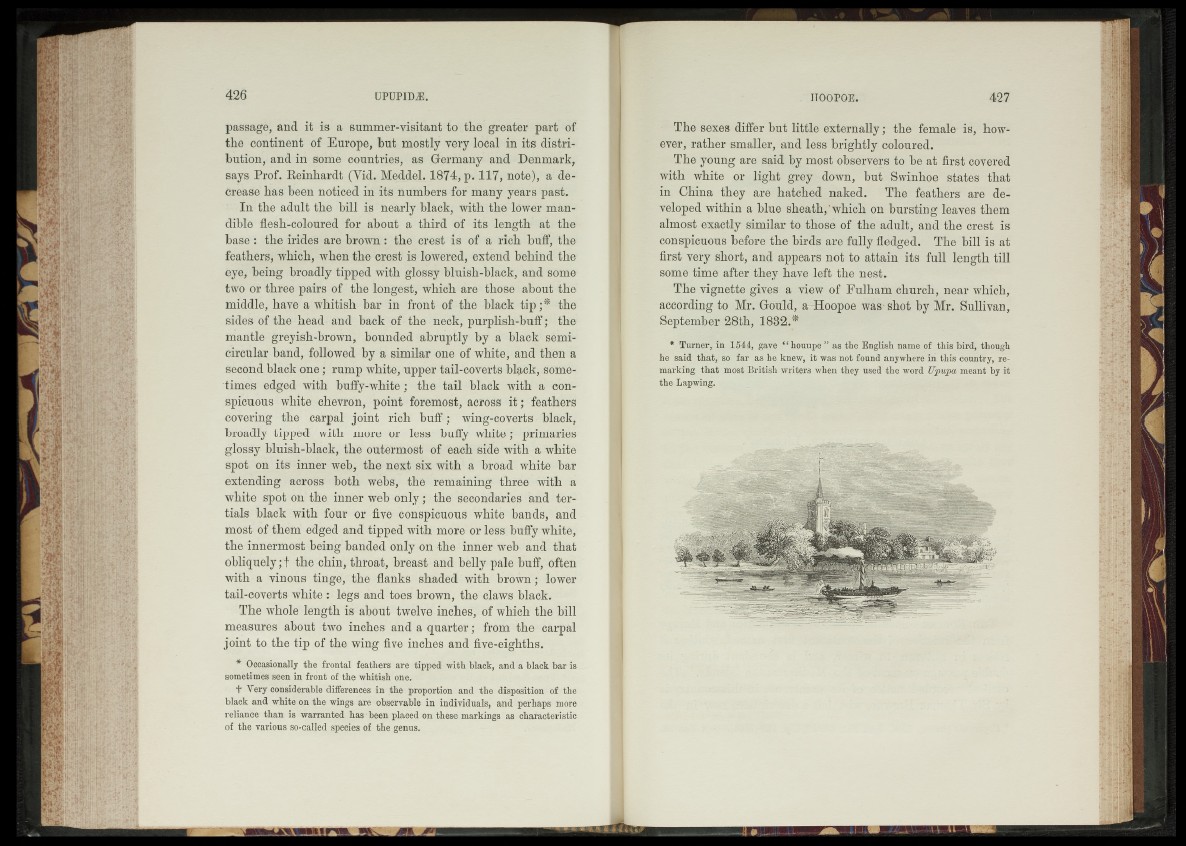
passage, and it is a summer-visitant to the greater part of
the continent of Europe, but mostly very local in its distribution,
and in some countries, as Germany and Denmark,
says Prof. Reinhardt (Yid. Meddel. 1874, p. 117, note), a decrease
has been noticed in its numbers for many years past.
In the adult the bill is nearly black, with the lower mandible
flesh-coloured for about a third of its length at the
base: the irides are brown: the crest is of a rich buff, the
feathers, which, when the crest is lowered, extend behind the
eye, being broadly tipped with glossy bluish-black, and some
two or three pairs of the longest, which are those about the
middle, have a whitish bar in front of the black tip;* the
sides of the head and back of the neck, purplish-buff; the
mantle greyish-brown, bounded abruptly by a black semicircular
band, followed by a similar one of white, and then a
second black one; rump white, upper tail-coverts bl^ck, sometimes
edged with huffy-white; the tail black with a conspicuous
white chevron, point foremost, across it; feathers
covering the carpal joint rich buff ; wing-coverts black,
broadly tipped with more or less huffy white; primaries
glossy bluish-black, the outermost of each side with a white
spot on its inner web, the next six with a broad white bar
extending across both webs, the remaining three with a
white spot on the inner web only; the secondaries and ter-
tials black with four or five conspicuous white bands, and
most of them edged and tipped with more or less huffy white,
the innermost being banded only on the inner web and that
obliquely ;t the chin, throat, breast and belly pale buff, often
with a vinous tinge, the flanks shaded with brown; lower
tail-coverts white : legs and toes brown, the claws black.
The whole length is about twelve inches, of which the bill
measures about two inches and a quarter; from the carpal
joint to the tip of the wing five inches and five-eighths.
* Occasionally the frontal feathers are tipped with black, and a black bar is
sometimes seen in front of the whitish one.
+ Very considerable differences in the proportion and the disposition of the
black and white on the wings are observable in individuals, and perhaps more
reliance than is warranted has been placed on these markings as characteristic
of the various so-called species of the genus.
The sexes differ but little externally; the female is, however,
rather smaller, and less brightly coloured.
The young are said by most observers to be at first covered
with white or light grey down, but Swinhoe states that
in China they are hatched naked. The feathers are developed
within a blue sheath,'which on bursting leaves them
almost exactly similar to those of the adult, and the crest is
conspicuous before the birds are fully fledged. The bill is at
first very short, and appears not to attain its full length till
some time after they have left the nest.
The vignette gives a view of Fulham church, near which,
according to Mr. Gould, a-Hoopoe was-shot by Mr. Sullivan,
September 28th, 1882.*
* Turner, in 1544, gave “ houupe ” as the English name of this bird, though
he said that, so far as he knew, it was not found anywhere in this country, remarking
that most British writers when they used the word Upupa meant by it
the Lapwing.